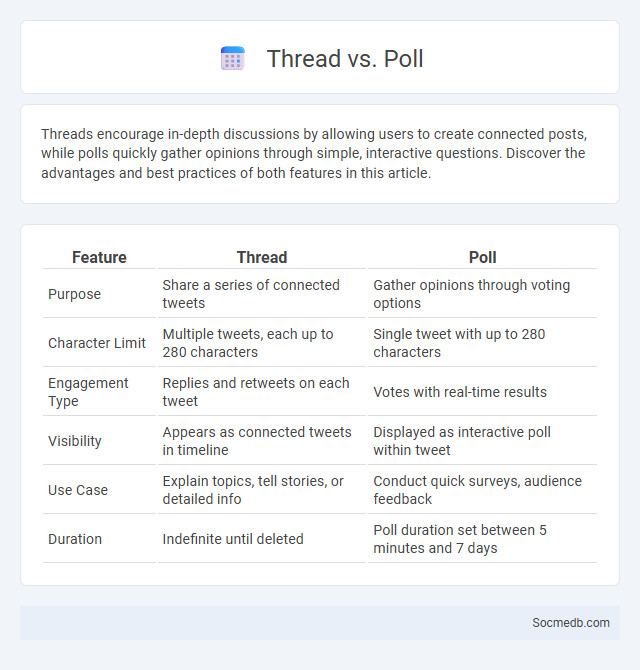
Photo illustration: Thread vs Poll
Threads encourage in-depth discussions by allowing users to create connected posts, while polls quickly gather opinions through simple, interactive questions. Discover the advantages and best practices of both features in this article.
Table of Comparison
| Feature | Thread | Poll |
|---|---|---|
| Purpose | Share a series of connected tweets | Gather opinions through voting options |
| Character Limit | Multiple tweets, each up to 280 characters | Single tweet with up to 280 characters |
| Engagement Type | Replies and retweets on each tweet | Votes with real-time results |
| Visibility | Appears as connected tweets in timeline | Displayed as interactive poll within tweet |
| Use Case | Explain topics, tell stories, or detailed info | Conduct quick surveys, audience feedback |
| Duration | Indefinite until deleted | Poll duration set between 5 minutes and 7 days |
Introduction to Thread, Poll, and Thread
Thread on social media platforms enables structured conversations by organizing replies under a specific post, enhancing clarity and engagement. Polls allow you to gather your audience's opinions quickly through interactive multiple-choice questions, driving participation and valuable feedback. Using threads combined with polls maximizes communication effectiveness and fosters a dynamic community interaction.
What is a Thread?
A Thread on social media is a series of connected posts or messages that expand on a single topic, allowing users to share detailed information in a structured way. You can follow Threads to keep up with ongoing conversations or updates without missing critical context. This format enhances engagement by organizing content logically and making it easier to navigate complex discussions.
What is a Poll?
A poll on social media is an interactive tool that allows users to gather opinions or feedback by asking questions with multiple answer choices. It enables quick engagement by encouraging Your audience to participate and express preferences, which helps in data-driven decision making. Polls often increase visibility and interaction rates across platforms such as Instagram, Twitter, and Facebook.
Key Differences: Thread vs Poll
Threads organize conversations by linking multiple posts within a single continuous flow, enabling detailed discussions and deeper engagement on specific topics. Polls gather audience opinions quickly by presenting predefined options, facilitating instant feedback and quantifiable results. Threads prioritize conversational depth and context, while polls emphasize rapid data collection and user interaction.
When to Use a Thread
Using a thread on social media is ideal when you need to share a detailed story, complex information, or step-by-step instructions that exceed character limits in a single post. Threads help maintain clarity and engagement by breaking content into digestible segments, making your message easier for Your audience to follow. Timing threads during peak engagement hours can maximize visibility and interaction on platforms like Twitter and LinkedIn.
When to Use a Poll
Using a poll on social media is effective when you need quick feedback or want to engage Your audience with interactive content. Polls work best for gauging opinions, making decisions, or sparking conversations on trending topics. They optimize user participation and provide valuable insights within minutes.
Pros and Cons: Thread vs Poll
Threads enable detailed discussions by allowing users to share multiple, connected messages that provide context and depth, enhancing engagement and clarity in complex topics. Polls offer quick, straightforward feedback or consensus through user voting, making them ideal for capturing opinions but limiting nuanced expression. Balancing threads and polls depends on the communication goal: threads for in-depth exploration and polls for rapid, quantifiable insights.
Real-World Examples: Thread and Poll Usage
Threads on social media platforms create organized, detailed conversations that improve user engagement by allowing participants to follow and contribute to specific topics easily. Polls boost interaction by inviting Your audience to vote and share opinions quickly, providing valuable feedback and increasing content visibility. Both tools enhance community building by fostering structured dialogue and real-time participation.
Best Practices for Choosing Between Thread and Poll
When deciding between using a thread or a poll on social media, consider the type of engagement desired; threads are ideal for sharing detailed information and encouraging in-depth discussions, while polls effectively capture quick audience opinions and preferences. Analyze audience behavior and platform algorithms, as threads can boost organic reach through sustained interaction, whereas polls provide instant feedback and increase participation rates. Prioritize clarity and purpose: use threads to educate or tell a story, and polls to make decisions or test ideas rapidly.
Conclusion: Optimal Communication Approach
Effective social media communication requires a strategic blend of consistency, authenticity, and audience engagement to maximize reach and impact. Tailoring your content to platform-specific algorithms and user behavior enhances visibility and drives meaningful interactions. By prioritizing these elements, you ensure your message resonates clearly and builds lasting connections with your audience.
 socmedb.com
socmedb.com